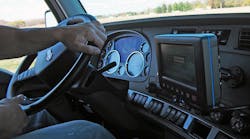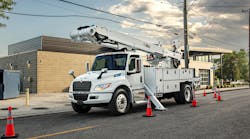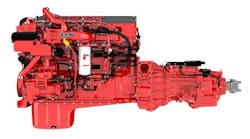As I've noted, commercial vehicle drivetrains are constantly breaking new ground these days. For fleet managers, it can be a lot to keep track of. And sometimes if can all seem a bit pointless: after all, trucks can only go so fast, and drivers can only drive so long during the course of a day.
And therein lies the point to all of these new tech: Going faster for longer hours is increasingly harder to do. And, with the advent of mandated electronic logging devices, it will soon be literally impossible to do without getting caught. So, the answer for truck fleets today is efficiency: Maximizing every second of available time and every mile of legal highway speed you have available to you in the course of a driver's work day.
And you're on the verge of getting at tool that is going to allow you to accomplish that goal in ways that seem unimaginable today.
Telematics aren't new. It's been around for years and has already proven to be a highly valuable tool for fleets engaged in both vocational and on-highway applications. But, in my opinion, the next generation of telematic vehicle systems will be a game-changer: A new technology so potent and effective that in five years' time, you'll wonder how you ever ran a fleet without it.
Here's why I think that:
Telematics systems are increasingly being tied in with a new generation of vehicle-to-vehicle communications systems and self-diagnosing powertrains. And the potential those two technologies have for fleets is obvious: Severely limit -- or even eradicate -- unscheduled downtime, instantly reconfigure drivetrain performance settings to meet any road or terrain condition at hand, and optimize available hours of service by rerouting around traffic congestion and accidents.
All those new systems will tie together through advanced telematics to completely transform fleet operations in the very near future.
Drivetrains will soon have the power to self-diagnose themselves and identify component failures before they happen. Electronic control modules, which are constantly making exponential leaps in computing power, will soon monitor a whole host of critical drivetrain telemetry in real time. This information will be constantly compared to an already-growing batch of Big Data being compiled by powertrain suppliers and OEMs to catch failures before they leave your driver sitting by the side of the road.
The system might, for example, detect a sudden sustained spike in coolant temperature along with a slight loss of system pressure and decreased resistance from the water pump pulley. A check with data wirelessly compiled over millions of hours of real-time use by the engine manufacturer will show that those conditions, combined with the number of miles on the engine and hours of operation correspond with an impending water pump failure in less than 500 miles.
At that point, electronic arrangements will begin to alert the driver and the fleet, locate a replacement water pump inside the 500 mile geofence, schedule a bay and an arrival time for the truck. Approvals and repair costs will be handled electronically as well.
But that's just the beginning. Let's say you've got trucks picking up cargo at the Port of Mobile, Alabama, and hauling those goods up to Chicago. Very soon, you'll be able to program those trucks to instantly adapt to their terrain conditions to insure the most efficient operation at all times. For example, the land north of the Gulf Coast is essentially flat. Your preprogrammed telematics system will recognize its location and request a fuel-map, torque and horsepower adjustment from your powertrain provider to meet those terrain conditions.
Later on in the trip, south of Birmingham, the terrain will begin to rise and hills will increase steadily as you draw near the Tennessee border and move up toward Kentucky. Again, your telematics system will recognize that terrain and have changed and will request a new set of engine operating parameters with higher horsepower and more torque to help the driver deal with those new driving conditions. Once the truck has crossed into Indiana and onto the Great Plains, the powertrain will once again update its powertrain settings and revert back to a lower horsepower operating mode to save fuel.
Your driver is saving additional time because he hasn't had to pull into any weigh stations on this trip, either. That's because your fleet has a good CSA score and this particular truck's overall health and maintenance record as well as its weight is available via telematics for State DOTs to electronically inspect. As your truck draws near a weigh station, the data is flashed to the DOT and quickly verified. Everything looks good, so your driver gets a message that he doesn't have to pull in. There's always a chance he might draw a random inspection -- but your fleet's CSA sore is so good, that rarely happens anymore.
Things start to tighten up as your driver nears Gary, Indiana. Traffic is increasing sharply, as is the presence of law enforcement. At this point, based on prior citations your fleet has gotten in this area, you could opt to use your telematics system to limit a truck's top speed in this area to 65 mph to help your driver avoid a speeding ticket. Meanwhile, in the cab, the driver has, in real time, received notification about a bad accident closing down the Interstate west of Gary. Using real-time data from vehicles actually stuck in the traffic jam, as well as public information data being provided by emergency response teams, the system will be able to accurately predict delay times, measure those times against available hours of service and scheduled delivery time while suggesting an alternate route that will cut over and bring him up to Chicago from the south to insure an on-time delivery.
It's all heady stuff. But it's also simple, practical and makes absolute sense from both a fleet, and a driver's, perspective. Telematics will mark a new era in hyper-efficient trucking. And it will all happen seamlessly, reliably with with almost no human management required.



